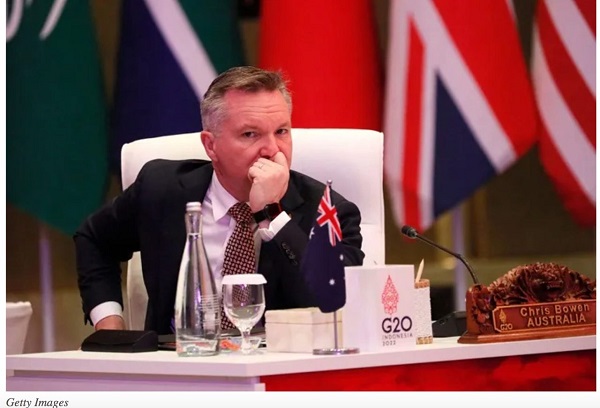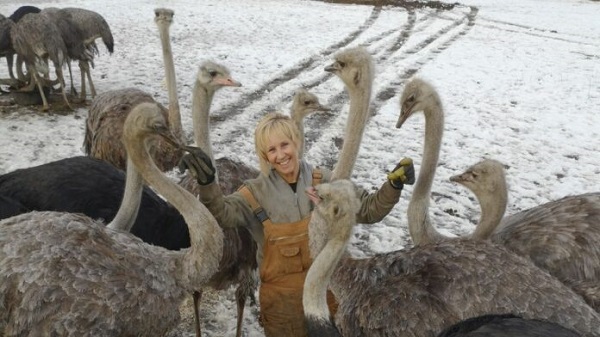Agriculture
Australia ignoring the solution to government-induced malaise

Australian PM Chris Bowen
From the Frontier Centre for Public Policy
By Alan Moran
Conscious of the imperative of self-preservation, European governments and the EU Commission itself have already taken baby steps to dilute and delay carbon emission-abating and economy-crushing agricultural and energy policies.. Not so in Australia
Studying last month’s Davos meeting of the world’s (largely self-appointed) elites, Walter Russell Mead sees an inflection point.
He says that when they listened to Argentinian President Milei promoting free market capitalism, the Davosies’ applause was more than polite clapping. There was a sense that all was not well in the supposed government-planned China, and a recognition that the more hands-on EU governmental approach has resulted in Europe slipping behind the US with its lighter government touch over the economy. This was coupled with a concern that the farmer revolts around Europe reflected a sudden rejection of trust in the establishment. Above all, Ukraine has made the Euro grandees ‘uncomfortably aware of how dependent the global system is on the leadership that only a prosperous and self-confident America can provide’.
Conscious of the imperative of self-preservation, European governments and the EU Commission itself have already taken baby steps to dilute and delay carbon emission-abating and economy-crushing agricultural and energy policies.
Not so in Australia, where governments remain totally focused on reducing the economy’s productive potential.
The Albanese government, under the Svengali and serial ministerial failure of Chris Bowen, has turbocharged carbon abatement programs crippling energy. It has:
- Vastly increased direct and regulatory-enforced expansion of the transmission lines in an attempt to allow wind and solar to work.
- Introduced a requirement for the top 215 businesses to reduce their emission levels by 30 per cent over and above reductions made necessary by the subsidies generally.
- Put in place measures to combat objections to intrusive wind farms and transmission lines.
- Refused to introduce requirements for the rectification of land and safe disposal of the materials used in wind and solar facilities.
- Vastly expanded the budgetary assistance to wind, solar, and hydrogen.
- Introduced costly requirements on firms to identify the emissions of their own activities and of those of their suppliers and customers.
The measures have been put in place by politicians, hardly any of whom have any knowledge of the energy sector, how it works, and what its costs are. Politicians have been pressed in this direction by the so-called experts, a professional elite supported by and bankrolled by subsidy-seekers, who see the global warming con as a means by which they can get paid for promoting particular forms of energy.
But the outcome is already apparent in the loss of competitiveness of our industries. The bellwether is smelting and all three of the major aluminium smelters are now in hospital care, relying on government support to offset the imposts they incur from government penalties on cheap electricity. The distress is also seen in agricultural and mining industries, which in addition to being buffeted by ever-increasing environmental costs, with their prices set globally, are seeing their margins come under pressure.
Every week brings another measure – last week we saw requirements on car retailers to ensure more fuel-efficient – higher cost cars are sold with penalties on sellers that fail to meet these requirements, penalties that will certainly increase the price Australians pay for motor vehicles.
This week, Environment Minister Tanya Plibersek boasted of spending $205 million of taxpayers’ money to buy back another 44 gigalitres of water from Murray irrigators. This is part of a process to divert 2,700 gigalitres per annum (out of 7,000 gigalitres ‘high security’ water available) from productive agriculture to uses designated as ‘environmental’. These measures massively reduce the productivity of the Murray-Darling region, responsible for 35 per cent of the nation’s farm income. They were originally justified to respond to environmental agitators’ spurious claims that irrigation was creating salt infusions, claims that were reinforced during the ‘millennial’ drought of 1997-2008 by specious assertions that climate change would drastically reduce the available water. These original rationales having been disproven, politicians’ and activists’ hostility to productive enterprise have lent the programs an ongoing inertia.
We also saw a new $100 billion a year in additional carbon tax floated by Ross Garnaut and Rod Sims; their study’s funding source was not revealed but the beneficiaries would likely be, in my opinion, subsidy-seeking economy wreckers. While ostensibly rejecting that proposal, the Prime Minister has foreshadowed extensive new decarbonisation spending programs. Nothing is being learned from the collapse of Australia’s nickel mining industry, which cannot compete with overseas mines favoured by the low-cost coal-generated electricity that Australian governments are closing down.
In addition to the current $10 billion a year in subsidies through regulations forcing the use of wind and solar, and billions of dollars spent on revoking the productive use of irrigation water, governments provide huge sums to groups that promote such waste. Unlike squandering through inefficiency that is endemic in government programs, all this spending is aimed at poisoning once highly competitive low-cost industries. Adding to measures that load the dice against employers in workplace relations, it is akin to government forcing the nation to manufacture bombs to be dropped on the people financing them.
Has anybody put the solution more succinctly than Trump-aligned Presidential hopeful, Vivek Ramaswamy? His answer was, ‘Drill. Frack. Merit over “Diversity, Equity, and Inclusion”. Stop paying people to stay at home instead of work. Fire bureaucrats. Shut down corrupt agencies. End lobbying.’
Alan Moran is a noted economist who has analysed and written extensively from a free market perspective focusing on environmental issues, housing, network industries, and energy markets. First published here.
Agriculture
Canada Greenlights Mass Culling of 400 Research Ostriches Despite Full Recovery from Bird Flu Months Ago

 Nicolas Hulscher, MPH
Nicolas Hulscher, MPH
Federal court upholds CFIA’s reckless cull order—setting a dangerous precedent for the unscientific mass depopulation of genetically important animals.
In March, I interviewed Katie Pasitney of Universal Ostrich and Connie Shields to discuss the alarming implications of the Canadian Food Inspection Agency (CFIA) order to cull 400 research ostriches at Universal Ostrich Farm in British Columbia over bird flu:
Canada Orders Mass Culling of 400 Research Ostriches Over Bird Flu, Refuses to Test Surviving Birds for Natural Immunity
·The Canadian Food Inspection Agency (CFIA) has ordered the culling of 400 ostriches at Universal Ostrich Farm in British Columbia, citing concerns over H5N1 bird flu. However, this decision is not based on sound science and could have serious consequences for both food security and medical research.
Universal Ostrich Farm is a research facility focused on studying the unique antibody-producing capabilities of ostriches. Their research has demonstrated potential in neutralizing viruses, bacteria, and even COVID-19, making it an important contribution to medical science.
In December 2024, the CFIA claimed that two deceased ostriches—which had been lying outside for over 16 hours—tested positive for H5N1 via PCR testing. Just 41 minutes after receiving these results, the CFIA signed an order to cull the entire flock.
The CFIA initially granted the farm an exemption, recognizing the birds as “genetically important.” Later, without clear justification, they reversed this decision, ordering their destruction.
Despite the importance of this research, the CFIA has refused to conduct further testing on the birds and has banned the farm from conducting its own tests, under threat of heavy fines and possible imprisonment. Why is the Canadian government refusing to study the potential antibodies ostriches have developed against H5N1 bird flu?
On January 31, 2025, a court granted a temporary stay of execution, halting the cull. However, the CFIA is appealing this decision, which means the culling could still proceed.
Today, we have received news that the reckless mass cull order will proceed despite their ostriches having already recovered months ago and developed natural immunity against H5N1:

Official Announcement: Federal Court Decision in Universal Ostrich Farms Inc. v. Canadian Food Inspection Agency
Dear friends and supporters,
We are absolutely devastated to share today’s Federal Court decision, issued on May 13, 2025. The court ruled in favour of the Canadian Food Inspection Agency (CFIA), upholding their order to destroy our beloved ostriches and rejecting our plea to save them.
The court’s decision accepted the CFIA’s justification under the Health of Animals Act and their use of the Stamping-Out Policy, which mandates the destruction of animals to control disease outbreaks, regardless of their health status. The court confirmed the CFIA’s approach, prioritizing trade obligations over the welfare of our animals.
In addition, we’ve been ordered to pay $15,000 in CFIA’s legal costs. You can read the full decision here: (2025 FC 878). https://saveourostriches.com/wp-content/uploads/2025/05/JR-T-294-25-and-T-432-25-Final.pdf
We are heartbroken by this outcome and uncertain about the future of our farm. As we navigate this incredibly difficult time, we ask for your patience and continued support. If you are able, please consider making a donation to help us manage the financial and emotional toll this has taken.
Thank you,
Universal Ostrich Farm
http://SaveOurOstriches.com
This deeply misguided decision sets a dangerous precedent for the Canadian government to recklessly depopulate animals at will.
By upholding the CFIA’s reckless cull order, despite the ostriches’ recovery and natural immunity, the court has prioritized trade protocols over scientific inquiry, animal welfare, and the advancement of life-saving medical research.
Epidemiologist and Foundation Administrator, McCullough Foundation
www.mcculloughfnd.org
Please consider following both the McCullough Foundation and my personal account on X (formerly Twitter) for further content.
Agriculture
Canada is missing out on the global milk boom

This article supplied by Troy Media.
 By Sylvain Charlebois
By Sylvain Charlebois
With world demand soaring, Canada’s dairy system keeps milk producers locked out of growth, and consumers stuck with high prices
Prime Minister Mark Carney is no Justin Trudeau. While the team around him may be familiar, the tone has clearly shifted. His first week in office signalled a more data-driven, technocratic approach, grounded in pragmatism rather than ideology. That’s welcome news, especially for Canada’s agri-food sector, which has long been overlooked.
Historically, the Liberal party has governed with an urban-centric lens, often sidelining agriculture. That must change. Carney’s pledge to eliminate all interprovincial trade barriers by July 1 was encouraging but whether this includes long-standing obstacles in the agri-food sector remains to be seen. Supply-managed sectors, particularly dairy, remain heavily protected by a tangle of provincially administered quotas (part of Canada’s supply management system, which controls prices and limits production through quotas and tariffs to protect domestic producers). These measures stifle innovation, limit flexibility and distort national productivity.
Consider dairy. Quebec produces nearly 40 per cent of Canada’s milk, despite accounting for just over 20 per cent of the population. This regional imbalance undermines one of supply management’s original promises: preserving dairy farms across the country. Yet protectionism hasn’t preserved diversity—it has accelerated consolidation.
In reality, the number of dairy farms continues to decline, with roughly 90 per cent now concentrated in just a few provinces. On our current path, Canada is projected to lose nearly half of its remaining dairy farms by 2030. Consolidation disproportionately benefits Quebec and Ontario at the expense of smaller producers in the Prairies and Atlantic Canada.
Carney must put dairy reform back on the table, regardless of campaign promises. The sector represents just one per cent of Canada’s GDP, yet
wields outsized influence on policy, benefiting fewer than 9,000 farms out of more than 175,000 nationwide. This is not sustainable. Many Canadian producers are eager to grow, trade and compete globally but are held back by a system designed to insulate rather than enable.
It’s also time to decouple dairy from poultry and eggs. Though also supply managed, those sectors operate with far more vertical integration and
competitiveness. Industrial milk prices in Canada are nearly double those in the United States, undermining both our domestic processors and consumer affordability. These high prices don’t just affect farmers—they directly impact Canadian consumers, who pay more for milk, cheese and other dairy products than many of their international counterparts.
The upcoming renegotiation of CUSMA—the Canada-United States-Mexico Agreement, which replaced NAFTA—is a chance to reset. Rather than resist change, the dairy sector should seize the opportunity to modernize. This includes exploring a more open quota system for export markets. Reforms could also involve a complete overhaul of the Canadian Dairy Commission to increase transparency around pricing. Canadians deserve to know how much milk is wasted each year—estimated at up to a billion litres—and whether a strategic reserve for powdered milk, much like our existing butter reserve, would better serve national food security.
Global milk demand is rising. According to The Dairy News, the world could face a shortage of 30 million tonnes by 2030, three times Canada’s current annual production. Yet under current policy, Canada is not positioned to contribute meaningfully to meeting that demand. The domestic focus on protecting margins and internal price fairness is blinding the sector to broader market realities.
We’ve been here before. The last time CUSMA was renegotiated, Canada offered modest concessions to foreign competitors and then overcompensated its dairy sector for hypothetical losses. This created an overcapitalized industry, inflated farmland prices and diverted attention from more pressing trade and diplomacy challenges, particularly with India and China. This time must be different: structural reform—not compensation—should be the goal.
If Carney is serious about rebooting the Canadian economy, agri-food must be part of the conversation. But that also means the agriculture sector must engage. Industry voices across the country need to call on dairy to evolve, embrace change and step into the 21st century.
Dr. Sylvain Charlebois is a Canadian professor and researcher in food distribution and policy. He is senior director of the Agri-Food Analytics Lab at Dalhousie University and co-host of The Food Professor Podcast. He is frequently cited in the media for his insights on food prices, agricultural trends, and the global food supply chain.
Troy Media empowers Canadian community news outlets by providing independent, insightful analysis and commentary. Our mission is to support local media in helping Canadians stay informed and engaged by delivering reliable content that strengthens community connections and deepens understanding across the country.
-

 Crime15 hours ago
Crime15 hours agoHow Chinese State-Linked Networks Replaced the Medellín Model with Global Logistics and Political Protection
-

 Addictions16 hours ago
Addictions16 hours agoNew RCMP program steering opioid addicted towards treatment and recovery
-

 Aristotle Foundation17 hours ago
Aristotle Foundation17 hours agoWe need an immigration policy that will serve all Canadians
-

 Business14 hours ago
Business14 hours agoNatural gas pipeline ownership spreads across 36 First Nations in B.C.
-

 Courageous Discourse12 hours ago
Courageous Discourse12 hours agoHealthcare Blockbuster – RFK Jr removes all 17 members of CDC Vaccine Advisory Panel!
-

 Health8 hours ago
Health8 hours agoRFK Jr. purges CDC vaccine panel, citing decades of ‘skewed science’
-

 Censorship Industrial Complex11 hours ago
Censorship Industrial Complex11 hours agoAlberta senator wants to revive lapsed Trudeau internet censorship bill
-

 Crime18 hours ago
Crime18 hours agoLetter Shows Biden Administration Privately Warned B.C. on Fentanyl Threat Years Before Patel’s Public Bombshells




